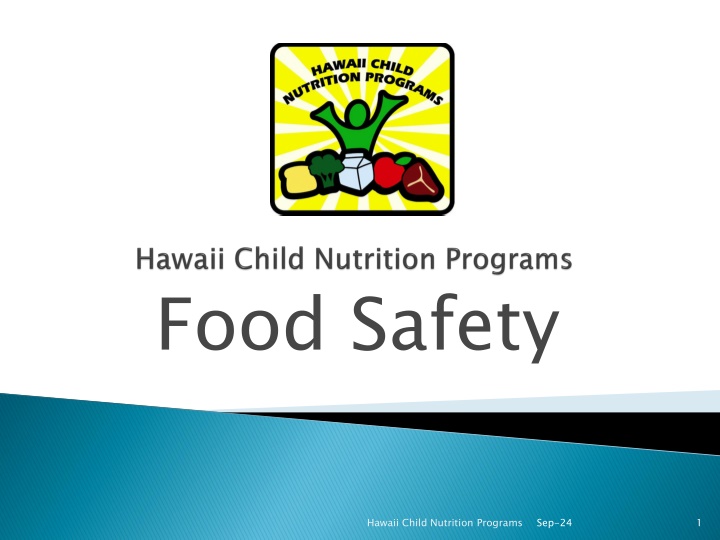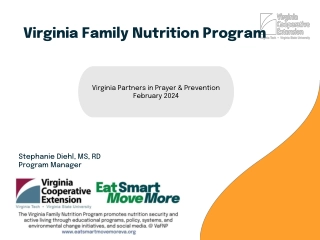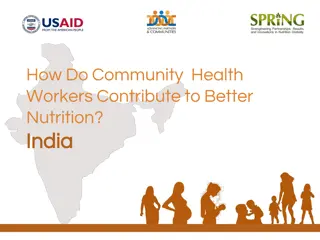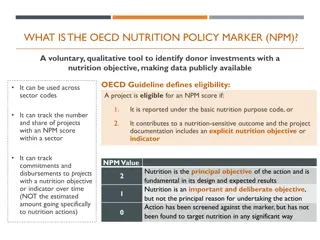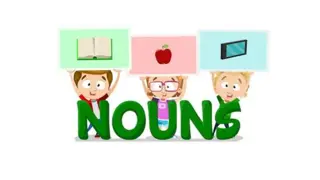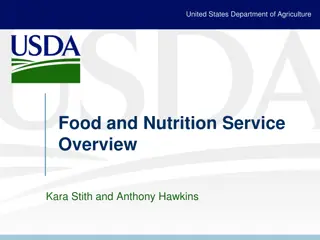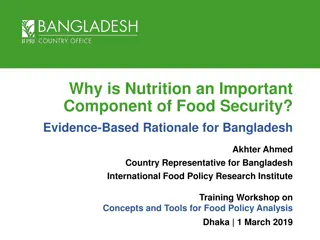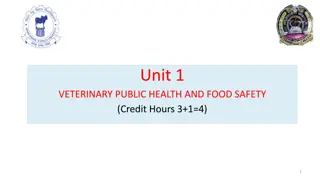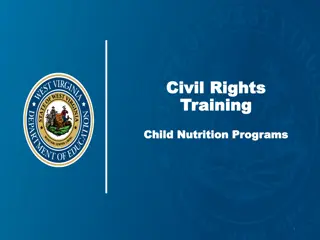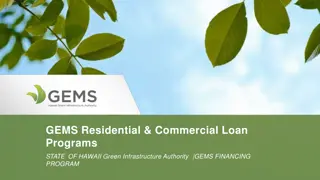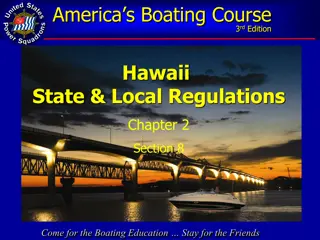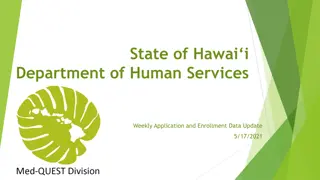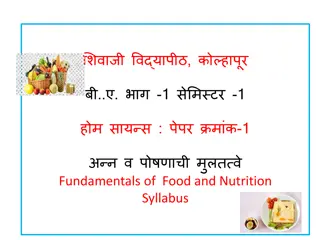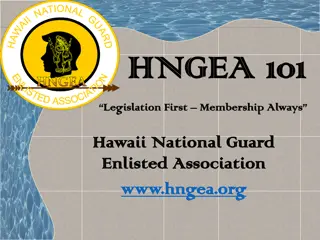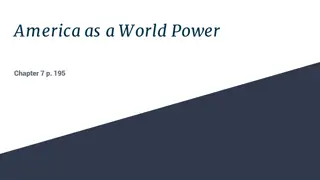Ensuring Food Safety in Hawaii Child Nutrition Programs
Food safety practices and guidelines are essential in Hawaii Child Nutrition Programs to prevent diseases like Rat Lungworm. Measures include thorough inspection and rinsing of produce, compliance with regulations for washing produce, and following protocols such as HACCP principles. Regular monitoring, corrective actions, and record-keeping are crucial for maintaining food safety standards.
Download Presentation

Please find below an Image/Link to download the presentation.
The content on the website is provided AS IS for your information and personal use only. It may not be sold, licensed, or shared on other websites without obtaining consent from the author.If you encounter any issues during the download, it is possible that the publisher has removed the file from their server.
You are allowed to download the files provided on this website for personal or commercial use, subject to the condition that they are used lawfully. All files are the property of their respective owners.
The content on the website is provided AS IS for your information and personal use only. It may not be sold, licensed, or shared on other websites without obtaining consent from the author.
E N D
Presentation Transcript
Food Safety Hawaii Child Nutrition Programs 1 Sep-24
Rat Lungworm Disease How is Rat Lungworm spread? Message: Thoroughly inspect and rinse produce, especially leafy greens, in potable water. Even if package states the produce has been prewashed, it is a State of Hawaii regulation to wash all produce before use. Hawaii Child Nutrition Programs 2 Sep-24
XFood safety plans are incomplete XFood safety plans are not being reviewed annually with corrective action not being taken or documented (SFA & Vendor) XAnnual food safety training on Standard Operating Procedures (SOP) not taking place. XFood safety inspections are not being requested twice a school year. XTemperature logs are not being completed. XFIFO not being followed properly XHACCP not being followed for FFVP. Hawaii Child Nutrition Programs 3 Sep-24
Schools Are Federal S Safety Plan Schools Are R Required by Federal L Law to Have a Food afety Plan B Based on HACCP Principles. equired by aw to Have a Food ased on HACCP Principles. Hawaii Child Nutrition Programs 4 Sep-24
A. Harry and Connie Clown Party B. Hepatitis A Cross Contamination Prevention C. Hazard Analysis Critical Control Points D. Happy Al s Cookie and Cracker Program Hawaii Child Nutrition Programs 5 Sep-24
What is HACCP? Hazard Analysis Critical Control Points What is HACCP? Why is it Important? Provides a systematic approach to identifying food safety hazards Why is it Important? http://www.fns.usda.gov/sites/default/files/Food_Sa fety_HACCPGuidance.pdf Hawaii Child Nutrition Programs 6 Sep-24
Conduct a Hazard Analysis Conduct a Hazard Analysis Determine Critical Control Points Determine Critical Control Points Establish Critical Limits Establish Critical Limits Establish Monitoring Procedure Establish Monitoring Procedure Hawaii Child Nutrition Programs 7 Sep-24
Identify Corrective Actions Identify Corrective Actions Keep Records Keep Records Review Revise as Necessary. Review Y Your Food Revise as Necessary. our Food S Safety Plan Annually and afety Plan Annually and Document Each Time Your Food Safety Plan is Reviewed. Document Each Time Your Food Safety Plan is Reviewed. Hawaii Child Nutrition Programs 8 Sep-24
Hawaii Child Nutrition Programs 9 Sep-24
Hawaii Child Nutrition Programs 10 Sep-24
Example Flow / Operational Steps to Consider Spinach & Romaine Salad Hawaii Child Nutrition Programs 11 Sep-24
Example Flow / Operational Steps to Consider Hamburger Patty Hawaii Child Nutrition Programs 12 Sep-24
Example Flow / Operational Steps to Consider Baked Lasagna Hawaii Child Nutrition Programs 13 Sep-24
https://whatscooking.fns.usda.gov/quantity/c hild-nutrition-cnp/meat-lasagna Hawaii Child Nutrition Programs 14 Sep-24
Purpose Purpose Instructions Instructions Monitoring Monitoring Corrective Action Corrective Action Verification and Record Keeping Verification and Record Keeping Hawaii Child Nutrition Programs 15 Sep-24
HCNP Website HCNP Website Click on Food Safety tab: Food Safety Program Standard Operating Procedures Tailor Existing SOPs to Individual SFAs Tailor Existing SOPs to Individual SFAs Hawaii Child Nutrition Programs 16 Sep-24
Review Your Food Safety Program Review Your Food Safety Program Annually Annually Revise and update as necessary Process Approach (Process 1, 2, 3) SOPs Danger Zone: 41 F - 135 F (Hawaii Food Rule since February 2014) Hawaii Child Nutrition Programs 17 Sep-24
Train Staff Annually on SOPs Record Temperatures Equipment Cooking Holding Receiving Storage Production Records Temperature Logs Invoices Delivery Receipts Train Staff Annually on SOPs Record Temperatures Hawaii Child Nutrition Programs 18 Sep-24
USDA Requires Schools to Have Sanitation Inspections Each Year USDA Requires Schools to Have TWO Sanitation Inspections Each Year TWO School Year: July 1 June 30 Applies to ALL Schools - Self-prep and Vended Each Site in Your SFA Hawaii Child Nutrition Programs 19 Sep-24
Complete Form O Inspection) Go to: http://hcnp.hawaii.gov/overview/nslp/ Click Food Safety Sanitation Inspection Complete Form O- -7 (Request for Sanitation Inspection) 7 (Request for Sanitation Submit to Your Local DOH Sanitation Branch Office Submit to Your Local DOH Sanitation Branch Office REMEMBER: Keep a Copy of Your Request REMEMBER: Keep a Copy of Your Request Hawaii Child Nutrition Programs 20 Sep-24
HCNP Recommends: HCNP Recommends: Submit your 1st request in September Submit your 2nd request in February Hawaii Child Nutrition Programs 21 Sep-24
Post Your Most Current Sanitation Inspection Post Your Most Current Sanitation Inspection Post in a publicly visible area like the main dining area This is a common finding during the Administrative Review Hawaii Child Nutrition Programs 22 Sep-24
Vended Meal Sites Vended Meal Sites Your vendor must also have a Food Safety Program Check that your vendor has implemented their Food Safety Program Check that your solicitation and/or contract with the vendor requires compliance with a Food Safety Plan Hawaii Child Nutrition Programs 23 Sep-24
Hawaii Child Nutrition Programs 24 Sep-24
In accordance with Federal civil rights law and U.S. Department of Agriculture (USDA) civil rights regulations and policies, the USDA, its Agencies, offices, and employees, and institutions participating in or administering USDA programs are prohibited from discriminating based on race, color, national origin, sex, disability, age, or reprisal or retaliation for prior civil rights activity in any program or activity conducted or funded by USDA. Persons with disabilities who require alternative means of communication for program information (e.g. Braille, large print, audiotape, American Sign Language, etc.), should contact the Agency (State or local) where they applied for benefits. Individuals who are deaf, hard of hearing or have speech disabilities may contact USDA through the Federal Relay Service at (800) 877-8339. Additionally, program information may be made available in languages other than English. To file a program complaint of discrimination, complete the USDA Program Discrimination Complaint Form, (AD-3027) found online at: http://www.ascr.usda.gov/complaint_filing_cust.html, and at any USDA office, or write a letter addressed to USDA and provide in the letter all of the information requested in the form. To request a copy of the complaint form, call (866) 632-9992. Submit your completed form or letter to USDA by: (1) Office of the Assistant Secretary for Civil Rights 1400 Independence Avenue, SW Washington, D.C. 20250-9410; (2) (3) mail: U.S. Department of Agriculture fax: (202) 690-7442; or email: program.intake@usda.gov. This institution is an equal opportunity provider. Hawaii Child Nutrition Programs 25 Sep-24
